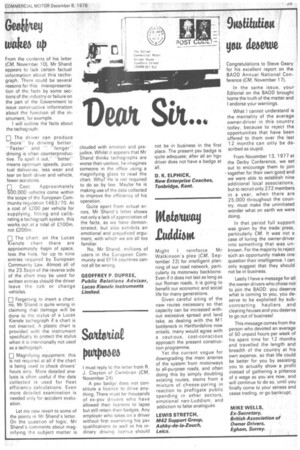Gesikteg wake up
Page 31

If you've noticed an error in this article please click here to report it so we can fix it.
From the contents of his letter (CM, November 10), Mr Shand appears to lack certain factual information about this tachograph. There could be several reasons for this: misrepresentation of the facts by some sections of the industry or failure on the part of the Government to issue constructive information about the function of the instrument, for example.
I will outline the facts about the tachograph:
O The driver can produce 'more'' by driving better. "Faster" and " "longer" driving is often counterproductive. To spell it out,"better" means optimum speeds, punctual deliveries, less wear and tear on both driver and vehicle, fewer accidents.
O Cost: Approximately 500,000 vehicles come within the scope of the European Community regulation 1463/70. At a cost of £200 per vehicle for supplying, fitting and calibrating a tachograph system, this works out at a total of £100m, not £200m.
O The chart on the Lucas Kienzle chart there are approximately 4sqin of space, less the hole, for up to nine entries required by European Community Law. Almost all of the 23.5sqin of the reverse side of the chart may be used for written entries should the driver leave the cab or change vehicles.
O Forgetting to insert a chart: no, Mr Shand is quite wrong in .claiming that damage will be done to the stylus of a Lucas Kienzle tachograph if a chart is not inserted. A plastic chart is provided with the instrument specifically to protect the stylus when it is intentionally not used as a tachograph.
O Magnifying equipment: this is not required at all if the chart is being used to check drivers' hours only. More detailed analysis is often useful if the data collected is used for fleet efficiency calculations. Even more detailed examination is needed only for accident evaluation.
Let me now revert to some of the points in Mr Shand's letter. On the question of logic, Mr Shand's comments about magnifying the subject matter is
clouded with emotion and prejudice. Whilst it appears that Mr Shand thinks tachographs are worse than useless, he imagines someone in the office using a magnifying glass to read the chart. Why? He is not required to do so by law. Maybe he is making use of the data collected to improve the efficiency of his operation.
Quite apart from actual errors, Mr Shand's letter shows not only a lack of appreciation of the facts, as we have demonstrated, but also exhibits an emotional and prejudiced argument, with which we are all too familiar.
No, Mr Shand, millions of users in the European Community and EFTA countries cannot all be wrong.
GEOFFREY P. DUPREE, Public Relations Adviser, Lucas Kienzle Instruments Limited.
































































































































